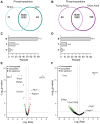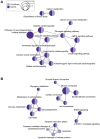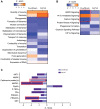Natural aging and ovariectomy induces parallel phosphoproteomic alterations in skeletal muscle of female mice
- PMID: 37580837
- PMCID: PMC10457050
- DOI: 10.18632/aging.204959
Natural aging and ovariectomy induces parallel phosphoproteomic alterations in skeletal muscle of female mice
Abstract
The loss of skeletal muscle strength mid-life in females is associated with the decline of estrogen. Here, we questioned how estrogen deficiency might impact the overall skeletal muscle phosphoproteome after contraction, as force production induces phosphorylation of several muscle proteins. Phosphoproteomic analyses of the tibialis anterior muscle after contraction in two mouse models of estrogen deficiency, ovariectomy (Ovariectomized (Ovx) vs. Sham) and natural aging-induced ovarian senescence (Older Adult (OA) vs. Young Adult (YA)), identified a total of 2,593 and 3,507 phosphopeptides in Ovx/Sham and OA/YA datasets, respectively. Further analysis of estrogen deficiency-associated proteins and phosphosites identified 66 proteins and 21 phosphosites from both datasets. Of these, 4 estrogen deficiency-associated proteins and 4 estrogen deficiency-associated phosphosites were significant and differentially phosphorylated or regulated, respectively. Comparative analyses between Ovx/Sham and OA/YA using Ingenuity Pathway Analysis (IPA) found parallel patterns of inhibition and activation across IPA-defined canonical signaling pathways and physiological functional analysis, which were similarly observed in downstream GO, KEGG, and Reactome pathway overrepresentation analysis pertaining to muscle structural integrity and contraction, including AMPK and calcium signaling. IPA Upstream regulator analysis identified MAPK1 and PRKACA as candidate kinases and calcineurin as a candidate phosphatase sensitive to estrogen. Our findings highlight key molecular signatures and pathways in contracted muscle suggesting that the similarities identified across both datasets could elucidate molecular mechanisms that may contribute to skeletal muscle strength loss due to estrogen deficiency.
Keywords: CAST; MAPK; PKA; calcineurin; estrogen deficiency.
Conflict of interest statement
Figures





References
-
- Agostini D, Zeppa Donati S, Lucertini F, Annibalini G, Gervasi M, Ferri Marini C, Piccoli G, Stocchi V, Barbieri E, Sestili P. Muscle and Bone Health in Postmenopausal Women: Role of Protein and Vitamin D Supplementation Combined with Exercise Training. Nutrients. 2018; 10:1103. 10.3390/nu10081103 - DOI - PMC - PubMed
-
- Maltais ML, Desroches J, Dionne IJ. Changes in muscle mass and strength after menopause. J Musculoskelet Neuronal Interact. 2009; 9:186–97. - PubMed
Publication types
MeSH terms
Substances
Grants and funding
LinkOut - more resources
Full Text Sources
Miscellaneous

